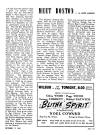| Home Page
Meet Boston Menu
In the business section that grew up before 1900 around the old Providence Depot in Park Square, it was felt that banking facilities were necessary to accommodate not only local establishments but shoppers, as well as commuters using the depot. The old Bay State Bank was the result, occupying a brick building with the old time parapet effects on the roof, facing Boylston Street opposite the Public Garden, while a rear entrance passage led to Park Square directly opposite the main depot entrance. With the opening of South Station, and with the subway taking much of the traffic off the surface of Boylston Street, the tides of Boston traffic swept away from Park Square, and that whole district suffered a rapid decline after 1900. The Bay State Bank was no exception to the rule, and it was taken over by the Old Colony Trust as the “Bay State Branch;” then it became a branch of the First National. The depression finished the old Bay State Bank, and that branch was closed in 1934 as an economy measure. The Park Square location had become a “dead location,” but not for long, for buses were bringing business back to Park Square. Not long after the Bay State Bank finally closed, the building was taken up by the Greyhound as a bus terminal―a worthy successor to the old Providence Depot. The old bank teller’s cage is now an information desk; the front desks of the bank have given place to the Colonial Line desk, and the bank’s inner offices are the bus baggage quarters. Time has gone its rounds, and Park Square has come back as a transportation center for Boston. * The Atlantic Avenue Elevated, with its five stations (Beach Street, South Station, Rowes Wharf, State Street, Battery Street), is a conspicuous relic of an earlier day on Boston’s waterfront. Originally built to supply rapid transit to South Station, and opened in 1901, shortly after South Station, it was originally an excellent through route between Roxbury and Charlestown which detoured the downtown rush. In addition, a loop service ran trains both ways along Atlantic Avenue, returning via the Tremont Street Subway, and giving direct service from downtown to all ports of the waterfront. This loop stopped in 1908, making the first step in the downfall of the Atlantic Avenue Elevated; what remained of it was a shuttle between North and South Stations. At South Station the passage from the depot to the Elevated is still to be seen; at Rowes Wharf there was connection with the old Narrow Gauge line to Revere Beach and Winthrop; at State Street a passage connected with the East Boston Tunnel; while Battery Street Station connected with the old North Ferry, and the Elevated there gave transfers to East Boston street cars across the ferry. In 1917, the Beach Street Station was closed. In 1919, the molasses tank explosion twisted a large section of Atlantic Avenue Elevated into wreckage; and the Atlantic Avenue Elevated was never the same since then. Curtailments of service followed, decreasing the Elevated usefulness, followed by more curtailment, till, on October 1, 1938, the service stopped altogether. The slow downfall of the service of the Atlantic Avenue Elevated brought with it a corresponding slowdown on Boston’s waterfront. That old elevated track was the main artery of the waterfront’s lifeblood.
|
